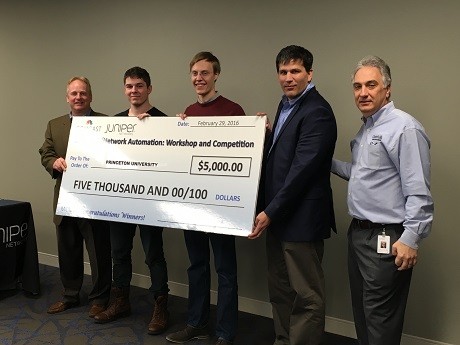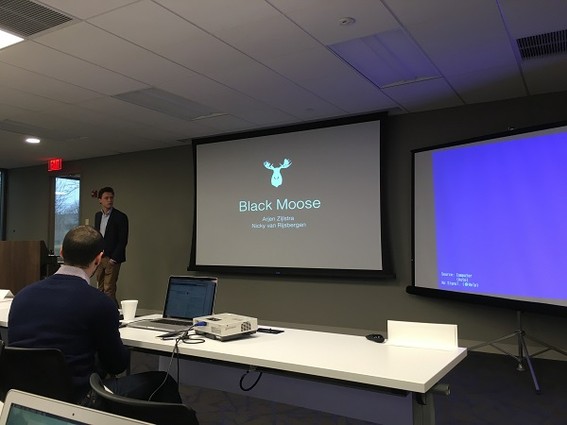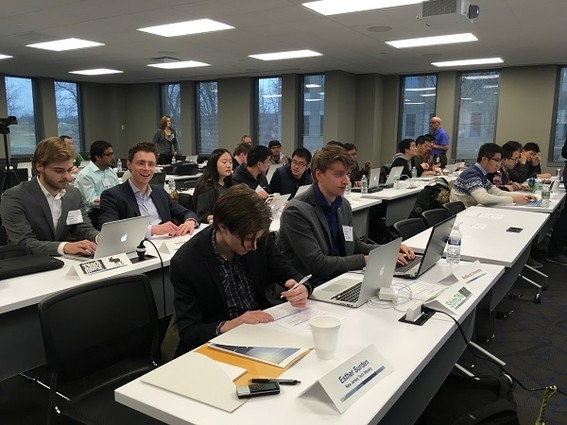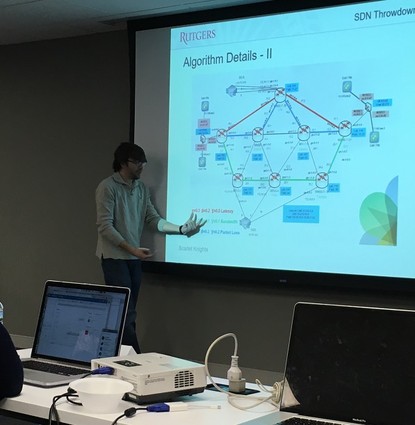Teams from Princeton, Rutgers and Penn Win Comcast, Juniper’s OpenLab “SDN Throwdown”

Ten student teams convened at Juniper’s OpenLab (Bridgewater) on Feb. 29 for presentations and demonstrations. This was the culmination of a specialized “SDN Throwdown” competition.
The program was designed to let student teams problem-solve by participating in an SDN networking challenge provided by Comcast.
The Throwdown, sponsored by Comcast and Juniper, drew 10 teams representing eight colleges and universities in the tristate area and beyond.
Two of the teams came from the Netherlands. They had won the opportunity to attend the week-long event through a competition at their respective universities.

The students spent two days on site at Juniper’s OpenLab, which has that company’s latest equipment and provides a solution-development environment for companies around the world.
They learned about Juniper and Comcast’s networking products and were taught the specifics of how to work with a network. They then went back to their schools (or, in the case of the international students, to their hotel) to do the rest of the work.
Jerry Passione, OpenLab’s general manager, explained the problem statement that the students had confronted to those assembled for demo day.
The student teams were asked to optimize the delivery of traffic across a large network. The network traffic was unpredictable and volatile, with changing conditions all the time.
The students were asked to monitor the network conditions and to reroute network traffic over alternate paths as needed, based on the network situation. They could encounter congestion, failing links, latency issues and other faults. The students worked with the Juniper NorthStar traffic optimization SDN WAN controller to provision and change the links, based on traffic conditions.

As part of the problem set, students had to create visualizations for how the network operated and use the tools to alter the network in near real time to optimize their paths. They had to react to changes and utilization and to identify the characteristics they were optimizing for. Finally, they were asked to generate multiple traffic flows simultaneously, in both directions, with different optimization characteristics. “The more parallel flows and the more variation in policy, the better,” they were told.
The teams had off-site access to the Juniper OpenLab network as they addressed the issues involved in traffic delivery across a large and unpredictable network. The assignment was supposed to provide them with an idea of the challenges encountered by a real network. The student teams were assigned coaches and had physical access to the OpenLab facilities if they so desired.
The students demoed their solutions in front of guests, peers and judges.
The panel of judges included Howard Applegate, director of network engineering at Comcast; Aaron Price, founder of the NJ Tech Meetup and the upcoming Propeller festival in Hoboken; and Oliver Schuermann, systems engineering director at Juniper.
Many of the student teams were able to show visualizations of their network solutions, and several explained algorithms that they had developed in order to deal with the network performance issues or faults they had encountered.
Winning the top prize — $5,000 for their school — was the team from Princeton University, called “SDX.” Team members Rüdiger Birkner, Arpit Gupta and Robert MacDavid looked at the problem of traffic delivery from a network operator’s point of view, and developed ways to avoid compromised nodes in real time.
They envisioned a modular, scalable solution that could handle random failures and other events. They also took into consideration different policies for multiple stakeholders in the system. “For example, if you need to avoid certain countries, the policies should be able to support this,” one of the Princeton presenters said. Latency is more important in some situations, but more bandwidth is needed in others.

The second-place winners, from Rutgers University, envisioned an adaptation of SDN for 911 networks. That team created a predictive mathematical model to forecast link failure and to direct calls away from links that were destined to fail.
Taking third place was the “Penn Defined Networks” team, from the University of Pennsylvania. They addressed the problem from the point of view of creating the next wide-area network for the Internet of Things. They also said that they could help customers control network costs by delivering an API that would predict the best pricing.
The students received some good advice from the judges prior to the announcements of the winners.
Price offered some pointers on making successful presentations and effective ways to communicate. “Keep in mind that there are human beings in the room,” he said, and you should be telling a story. “Talk to the lowest common denominator, the dumbest guy in the room.” There is likely to be a business development or marketing person in the room when you are making these presentations, he said. Price also suggested that the students video record themselves to figure out what they should change.
Schuermann said that the identification of the problem and your solution is important to include in presentations. Weave the technical aspects into the marketing perspective, and give each part equal time, he advised. “The continued summarization as you got through each part was fantastic in some of these presentations.”
Applegate said that he was “humbled by the talent in the room.” He added that there were a lot of very innovative ways in which technology had been applied to solve the problem of traffic delivery, but he noted that sometimes the presentations hadn’t tied the technology, solution and problem statement all together.

